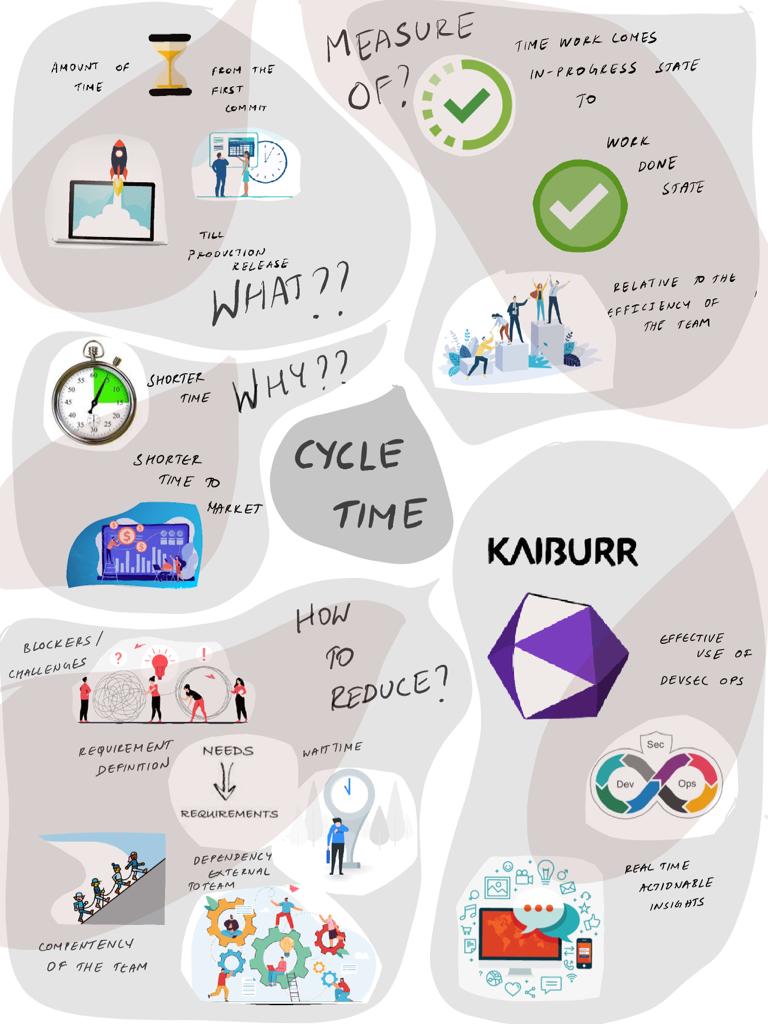Leaders and Managers across Software development organizations like their teams to build software products and implement changes in quick time. They would be very happy if there is some magic wand, just swoosh with a hand and see their desired features delivered to customers. Teams operating under a good culture, high performance environment and a right leader delivers new features at a very fast clip.
The time it takes for a new feature, idea, or some type of modification, from the moment it is implemented upon to reach production and eventually the customer is the Cycle Time.

It could be described in terms of opportunities. It indicates a Change implemented in a certain amount of time compared with its target. The faster the Cycle Time, the faster the company can react to market changes. As the right culture builds up and DevOps maturity grows, Cycle Time becomes shorter and shorter.
Cycle time
This concept has its roots in the manufacturing industry, specifically lean manufacturing. But its applications stretch farther than that and into multiple domains. In layman terms, cycle time is the exact time it takes to complete a process – it is a measurement. Cycle time can be measured for a complete workflow or a part of a process.
In software development, cycle time measures the amount of time from the start of a task to its completion. It records the amount of time elapsed since the time work is started to when it is ended.
Cycle Time is a measure of how quickly work passes through the system from the time work comes to the “In-Progress” state to the “Done” state.
Cycle Time provides interesting insights into the Engineering Practices in a team. It is closely related to the efficiency of the team and also provides indicators of wait times and other impediments which could affect the efficiency.
Why is it important ?
Cycle time provides an indication of when the customer can start expecting deliverables. There are various metrics out there that relate to cycle time. But one rule to keep in mind, a smaller cycle time is indicative of a shorter time-to-market and is sometimes associated with a quicker ability to validate deliverables to end customers. If the Cycle Time isn’t improving, the process needs to be relooked and the underlying System technology may need to be changed.

Different ways to reduce Cycle time
- Start small and fast to produce customer deliverables quickly
- Use automated tools to save effort and time. It helps during continuous integration.
- Break work items into smaller chunks and iterate frequently. It can also help reduce review time for Pull requests.
- Assess product value for Customers and attempt market analysis before release.
- Test-driven development.
- Reduce Coding Time
- Improve requirements
- Break down the work into smaller chunks
- Refactor hairy code
- Improve Pickup Time
- Coordination and communication
- Deliberate context switches
- Effective Reviews
- Done is better than started, do not delay.
- Cultivate more reviewers
- Better design upfront
- Reduce Time to Deploy
- Improve CI/CD pipeline
- Great testing practices
- Smaller deployments
- Effective use of DevSecOps tools and practice on continuous improvement.
- Optimal DevSecOps operations with high availability and self-service
The Payoff with Improved Cycle Time.
-
- Shorter learning cycles.
- Decreased delivery risk.
- Greater productivity overall.
- Operates like Elite Teams.
You can be assured of Engineering Excellence on regular use of Kaiburr Platform.
-
- Kaiburr ensures success for engineering and product leaders
- Real time guidance on Velocity, Productivity, Predictability, Quality, and Compliance
- Real time Analysis and insights/suggestions for improvement on various metrics.
- 600 best practices, 350+ KPI’s on end-to-end software delivery lifecycle.
- Practically Alexa for software product development.
Kaiburr helps every product engineering team to meature their performance near real time using industry standard KPIs like the below.

Mean Time to Change (MTTC) here is the same as Cycle Time. You can then drill down to specific trends in cycle time for a portfolio, project, initiative, team, epic, sprint or release like the below –

Reach us at contact@kaiburr.com to get started with metrics driven continuous improvement in your organization.
